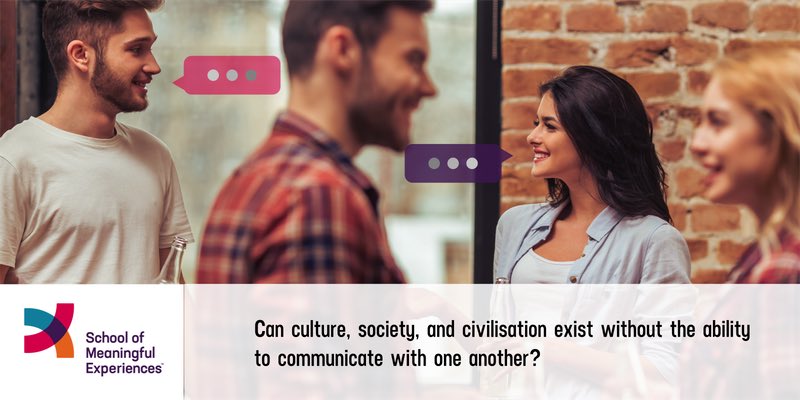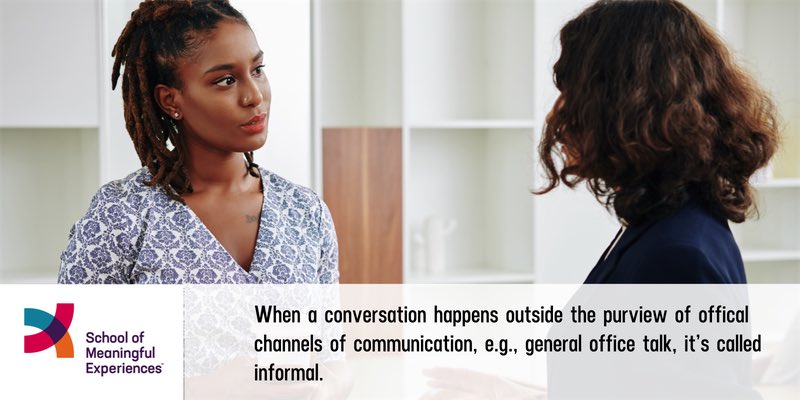Communication is exchanging information between individuals using a common system of symbols, signs, or behaviour. Communication is important in our lives because it allows people to exchange their ideas, opinions, information, and feelings. It is a critical tool that plays an important role in any organisation's growth.
Effective communication assists workers in adjusting to the physical and social aspects of their jobs. It also improves the industry's human relations. An effective communication system enables management to motivate, influence, and satisfy subordinates, which boosts morale and keeps them motivated. Two-way communication fosters cooperation and mutual understanding among employees and between employees and management. This results in less friction and, as a result, industrial peace and efficient operations in the factory.
“Sometimes not speaking says more than all the words in the world,” said Colleen Hoover, author of the popular novel It Ends with Us.
The quote encapsulates communication's critical role in our personal and professional lives. Communication is essential to the existence and survival of both human beings and organisations. It creates and transmits ideas, information, perspectives, facts, and feelings from one location, person, or group to another.
All creatures on Earth have evolved ways to communicate their emotions and thoughts to one another. However, humans' ability to use words and language to convey specific meanings separates them from the animal species.

Communication's significance cannot be overstated. After all, culture, society, and civilisation cannot exist without the ability to communicate with one another. Good communication prevents wars and misunderstandings, assists us in meeting our needs, establishes rules and laws that aid in the structuring of society, assists people in finding and keeping jobs, provides information and guidance, and passes down cultural traditions, norms, and values.
Distinguishing the Patterns of Communication
Communication patterns can be distinguished as verbal or nonverbal.
- Verbal Communication: Verbal is the spoken language, which includes not only the language and words spoken but also the tone, cadence, and speed, as well as formal versus informal language.
- Non-verbal Communication: Posture, facial expressions, body movements, gestures, eye contact, nodding in agreement, looking away and sighing, and a variety of other gestures are some examples of non-verbal communication.
- Virtual Communication: Although a type of non-verbal communication, virtual communication has become a form of communication in itself with the advent of smartphones and internet technologies. Virtual communication has the potential to connect people all over the world. Zoom, Google-meet, Instagram, Twitter, Facebook, and numerous other social media platforms have changed how we communicate. Signs and symbols that communicate or convey a concept, as well as audiovisual aids for presentations, are examples of virtual communication. A most prominent example is the use of emoticons in mobile communication.
Communication Styles in a Workplace
There are two styles of communication styles in an organisation: Formal and Informal. The main distinction between them is that formal communication is supported by predefined channels, whereas informal communication is not. Organisational communication is generally a mix of both formal and informal communication. Let's understand these types of communication in detail.
What is Formal Communication?
Formal communication is described as communication in which communication gets delivered or occurs via predefined channels or established channels of the organisation. It is also referred to as official communication. The main goal of this communication is to converse properly and ensure that the information is delivered correctly.
Formal communication is considered effective because it saves time through its systematic flow of information. The communication follows a hierarchical chain of command that the organisation has already established. In general, this type of communication is only used at work, and employees are required to use it while performing their duties. Reports, job descriptions, work orders, sales and inventory information, and so on are a few examples of formal communication.
One of the major drawbacks of formal communication is that the rules and regulations are strict. Consider, for instance, the weekly or monthly meetings and team meetings that your manager may request.
Useful Resources: advanced communication for professionals | online communication skills course

Types of Formal Communication
- Vertical - Communication takes place between different organisational levels here. As a result, the message is either passed from juniors to team leaders, to the manager, or vice versa.
- Horizontal -This is the exchange of information between peers from different departments.
- Diagonal - As the name implies, the conversation occurs between two employees working at different levels in various functional departments. For example, A web page designer discussing a project with a marketing manager can be classified as crosswise or diagonal communication.
Examples of Formal Communication
- Formal Report to the Board of Directors:
The Chief Financial Officer prepares a formal financial report, detailing the company's financial performance for the past quarter, to be presented during the board of directors' meeting. The report includes comprehensive data, graphs, and analysis of key financial metrics. It follows a specific structure and adheres to the organisations reporting guidelines. The report aims to provide the board with an in-depth understanding of the company's financial health and highlights potential areas for improvement. This formal communication ensures transparency and supports the board's decision-making process. - Formal Memo from HR to All Employees:
The Human Resources department issues a formal memorandum to all employees regarding the upcoming annual performance appraisal process. The memo outlines the timeline, guidelines, and expectations for the performance review cycle. It provides clear instructions on how to prepare self-assessments, schedule meetings with managers, and the criteria used for performance evaluations. This formal communication ensures consistency across the organisation and sets the expectations for the performance appraisal process, helping employees and managers to align their efforts and contribute to the company's overall performance.
What is Informal Communication?
Informal communication is multifaceted. In an organisational context, informal communication is free-flowing communication between subordinates and superiors. People converse freely without any restriction.
It is unofficial in nature and is based on the informal social relationships that develop in the workplace outside of the normal business hierarchy. This type of communication is quick and rapid because it moves freely in all directions. This type of communication is extremely natural in organisations as people interact with one another about their professional lives, personal lives, and other matters. For instance, sharing feelings, casual conversation, gossiping, talking about their families, etc.
One of the primary benefits of informal communication is its adaptability. There is no formality to obstruct or it does not limit communication. But the disadvantage of this type of communication is that it can also spread rumours and misinformation rapidly.
Read More: Style or substance: what is more important in oral communication?

Types of Informal Communication
- Single Strand String - This type of communication occurs when one individual share an idea or information with another, who then passes it on to another person, and so on like a cycle.
- The Cluster Community - How quickly a social media challenge goes viral is a perfect example of a cluster chain. For instance, when a person starts something unique and gives a challenge to three of his friends, they finish it, tag three more people, and so forth. This is how a cluster chain communication begins and grows.
- The Gossip Chain – Imagine canteen or coffee break session discussions, in which one person describes her recent experiences about her relationship or about the movie she watched last night with a group of friends gathered. That is how the gossip chain works. One person starts the conversation and shares information with a group of people, who then pass it on to others.
Examples of Informal Communication
- Informal Discussion Among Team Members:
During a coffee break, team members from different departments engage in an informal discussion about an upcoming project. They share their thoughts, ideas, and concerns in a relaxed setting without any predefined structure or agenda. The conversation flows freely, and team members brainstorm potential solutions and creative approaches to address challenges. This informal communication allows for a more relaxed exchange of ideas, fostering creativity and building camaraderie among colleagues. - Informal Instant Messaging Among Coworkers:
Two colleagues, working in adjacent cubicles, use instant messaging to chat informally about a quick question. Instead of sending a formal email, they exchange messages in a casual manner, discussing a project-related topic. This informal communication is less time-consuming and provides a quick solution to their immediate query, facilitating efficient collaboration within the workplace.
Differences Between Formal and Informal Communication
Maintaining a clear and cordial work culture requires both formal and informal communication. But what distinguishes casual conversations from formal meetings?
| Differences | Formal Communication | Informal Communication |
| Nomenclature | Formal communication is also known as official communication | Informal communication is also called Grapevine communication |
| Mode | Formal communication is generally documented but can sometimes be communicated verbally and recorded later, e.g., minutes of the meeting | Informal communication is always undocumented and happens outside the purview of official channels |
| Command | Formal communication follows a chain of command which can extend from the Vice President to an Executive, through various intermediaries such as managers and team leaders | Informal communication happens without a chain of command or hierarchy, for e.g., an informal conversation can theoretically happen directly between the VP and Executive |
| Objective | The sole motive of formal communication is to meet organisational goals and objectives | Informal communication is often driven by personal interests and needs |
| Reliability | Formal communication can be relied upon and any errors or miscommunication can be traced and corrected | Informal communication is unreliable and correction is generally not possible until it's too late in the process |
| Confidentiality | Formal communication is designed to maintain high levels of secrecy, and is layered to include “eyes only” information | Informal communication lacks confidentiality and often spreads in form of heresy, rumours, and gossip |
| Speed | Formal communication is time consuming as proper guidelines and formats need to be followed | Informal communication is speedy, as it generally spreads through verbal communication or virtual communication |
Both types of communication are necessary for the workplace, but informal communication is more beneficial because it can bridge departmental gaps and foster a sense of belonging and bonding.
Read More: Role of Body Language in Communication
Concluding thoughts
Nowadays, most organisations prefer an open-door policy that encourages both formal and informal communication. Most businesses strive to effectively blend formal and informal communication channels. It eventually improves employee productivity, efficiency, and transparency. However, the mode of communication should change depending on the circumstances. Because everyone has both official and unofficial situations, it is critical to balance the two modes of communication.
If your formal communication is not fluent enough, it may result in poor customer relations and, ultimately, put your job at risk. While some people have the ability to communicate fluently, others may need to work on it over time. As a result, rather than fearing the abilities of others, it is critical to focus on the purpose of communication.
Informal communication can also be used for much more than just friendly banter. This communication can be extremely beneficial in resolving a conflict between employees and management.
The end result is, however, increased efficiency, productivity, and employee trust from the entry-level to the team leader and the manager.




















